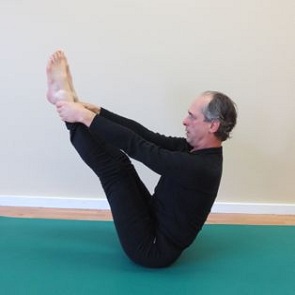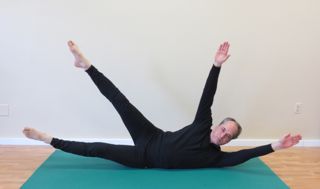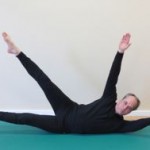I know what you’re thinking. This guy’s nuts! Joe Pilates emphasized breathing above all else as found in his books and films, and as told by Pilates Elders. But stay with me a moment, because as surprising as it sounds, I think you’ll agree!
The Cardinal Principle
Breathing was so important to Joseph Pilates that a strong argument can be made that breathing was his MOST important principle. After all there’s the famous line from his book, Return to Life Through Contrology, “…above all, learn how to breathe correctly.”(p.13) And in a recent interview with the Pilates Elder Mary Bowen, she remembers hearing Joe’s words resounding throughout his studio like a broken record “In d’air! Out d’air!” in his German accent.
But nowhere in surviving films do we see Joe or Clara teaching a breathing technique. Patterns yes – wonderful breathing patterns for each exercise – but no techniques. Mary Bowen confirms that he never mentioned one in all the years she practiced weekly in his studio. Yes, he preferred inhaling through the nose, but never made it a rule, and he often encouraged a complete exhale to foster a fuller inhale, but never insisted upon it.
So where have all our Pilates breathing methods come from? Lateral breathing, percussive breathing, ocean breathing and so many more described in books and on Youtube? More importantly, are they necessary?
A Brief History of Pilates Breathing
 We know that some of Joe’s students introduced special breathing techniques after he died. Most notably Ron Fletcher introduced ‘percussive breathing’ also known as ‘active breathing’ – characterized by short and repeated hissing sounds on the exhale. Now where the heck did this come from? Well, Ron was among the most advanced of Joe’s students, and I believe Joe shared a breathing technique he learned in his body-building days. It’s common not only to body-building but also to high-altitude climbing and deep-sea diving. It’s breathing forcefully and with some resistance on the exhale. Sounds complex but it’s actually not, and anyone can see it in action today in any weight room in any gym. Research confirms that it increases the body’s absorption of oxygen. I believe Joe shared this with Ron not as an essential or even important tool but rather as simply a way to get more out of a workout.
We know that some of Joe’s students introduced special breathing techniques after he died. Most notably Ron Fletcher introduced ‘percussive breathing’ also known as ‘active breathing’ – characterized by short and repeated hissing sounds on the exhale. Now where the heck did this come from? Well, Ron was among the most advanced of Joe’s students, and I believe Joe shared a breathing technique he learned in his body-building days. It’s common not only to body-building but also to high-altitude climbing and deep-sea diving. It’s breathing forcefully and with some resistance on the exhale. Sounds complex but it’s actually not, and anyone can see it in action today in any weight room in any gym. Research confirms that it increases the body’s absorption of oxygen. I believe Joe shared this with Ron not as an essential or even important tool but rather as simply a way to get more out of a workout.
OK but what about the most common of all our Pilates breathing methods, ‘lateral breathing?’ Here’s another interesting story. It seems to first appear on the scene when physical therapists realized the tremendous power of Pilates for rehabilitation and started integrating Pilates into their work. Lateral breathing is simply the physiological description of what happens when we breathe deeply with a strong and engaged core – belly breathing is eliminated, forcing us to breath in a new way. Somewhere along the line we turned the description into a prescription, showing students how to do it rather than letting it occur naturally as the core gets stronger. Lateral breathing and so may other well-meaning techniques have become part of our teaching curriculum. Consequently, we’ve made learning Pilates harder than it needs to be and thus more time-consuming and expensive. As our colleague Joan Breibart has said, “Pilates is not rocket science!”
A New Pilates
 Let’s return a measure of simplicity to this marvelous method without squashing innovation. Let’s make Pilates quick and easy for beginners to learn. After all, this is how Joe originally taught – he asked people to learn the form and breathe! I believe he knew that there’s no breathing method more important than just breathing, and that learning the form is quite enough for most beginners. We all know as teachers that as the form becomes familiar, breathing becomes relaxed and fuller. Here’s where the body and mind are ready for a next step. Here’s where breathing patterns and alignment muscle articulation become enjoyable and even natural rather than overwhelming. For the vast majority of beginners anything but the form just muddies the waters.
Let’s return a measure of simplicity to this marvelous method without squashing innovation. Let’s make Pilates quick and easy for beginners to learn. After all, this is how Joe originally taught – he asked people to learn the form and breathe! I believe he knew that there’s no breathing method more important than just breathing, and that learning the form is quite enough for most beginners. We all know as teachers that as the form becomes familiar, breathing becomes relaxed and fuller. Here’s where the body and mind are ready for a next step. Here’s where breathing patterns and alignment muscle articulation become enjoyable and even natural rather than overwhelming. For the vast majority of beginners anything but the form just muddies the waters.
I think I know where all our complex instruction came from. This marvelous method is just packed with exciting discoveries from the incredible power of our growing awareness of this amazing mind/body integration! Phew, that was a mouthful! But that’s been my experience – a thrilling journey that I want to share! We all want to share the joy! Ah, but here’s where we can take a page from the world of psychotherapy. We deny our students something very important when we tell them what to experience rather than help them discover it on their own. A firm core occurs naturally by doing the exercises faithfully – no need for ‘navel to spine’ or the ‘c-curve’ or identifying the psoas or inner abs! And lateral breathing occurs naturally when the core is developed and engaged – no need to teach it! This simplicity is part the brilliance of Pilates, or to paraphrase Joe, “Just do the exercises and breathe!”
May I recommend that if a breathing technique or cue helps someone who is having trouble, by all means use it! Otherwise let’s keep them to ourselves. They are not necessary and so apt to be unhelpful. Let’s get back to basics and make Pilates simpler, easier, less time-consuming and less expensive.
Oh, and to all the Pilates teachers reading this, my bottom line is that no matter how you teach, you’re wonderful! So please forgive me if this article has in any way discouraged or insulted you. Keep up the fine work!
About the Author
 Bob Hannum is the author of instructional books and videos specializing in mat Pilates. His latest book is High Intensity Pilates. Find him at PilatesLessons.org and on Facebook.
Bob Hannum is the author of instructional books and videos specializing in mat Pilates. His latest book is High Intensity Pilates. Find him at PilatesLessons.org and on Facebook.

